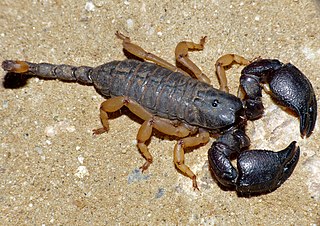
Opistophthalmus is a genus of scorpions known commonly as burrowing scorpions, tricolored scorpions, serkets, or hissing scorpions. They are found predominantly in southern Africa. They are known for making deep and elaborate burrows.
Hemiscorpius is the sole genus of the scorpion family Hemiscorpiidae, with about 16 described species. Before Hemiscorpiidae, the term used for the family was Ischnuridae, which had to be changed due to a naming conflict with the damselfly family of the same name. They at one point also held the name Liochelidae.

Centruroides is a genus of scorpions of the family Buthidae. Several North American species are known by the common vernacular name bark scorpion. Numerous species are extensively found throughout the southern United States, Mexico, Central America, the Antilles and northern South America. Some are known for their interesting patterning or large size ; most if not all fluoresce strongly under ultraviolet illumination, except after moulting. They contain several highly venomous species, and fatalities are known to occur. The venom of the Mexican scorpion Centruroides limpidus limpidus contains the neurotoxins Cll1 and Cll2.

Pandinus is a genus of large scorpions belonging to the family Scorpionidae. It contains one of the most popular pet scorpions, the emperor scorpion . The genus is distributed across tropical Africa.

Vaejovidae is a family of scorpions, comprising 25 genera and 227 species, found in North America. The species of the genus are found in Mexico and the southern United States, and Paruroctonus boreus is found in Canada and is the northernmost species of scorpion in the world.

The Scorpionidae make up the superfamily Scorpionoidea. The family was established by Pierre André Latreille, 1802.

Urodacus is a genus of scorpion belonging to the family Urodacidae. It was described by German naturalist Wilhelm Peters in 1861. The type species is U. novaehollandiae. Its species are native to Australia, and dig burrows. The genus was placed in its own family in 2000. Before this, the group had been a subfamily Urodacinae within the family Scorpionidae.

Urodacus manicatus, commonly known as the black rock scorpion, is a species of scorpion belonging to the subfamily Urodacinae. It is native to eastern Australia.

Opisthacanthus is a genus of scorpions in the family Hormuridae occurring in Central and South America, the Caribbean, Africa and Madagascar.

Hormurus karschii is a species of scorpion belonging to the family Hormuridae.

Liocheles australasiae, the dwarf wood scorpion, is a species of scorpion belonging to the family Hormuridae.

Hormuridae is a family of scorpions in the order Scorpiones. There are about 10 genera and more than 90 described species in Hormuridae.

Hadrurus hirsutus, also known as the desert hairy scorpion, is a species of scorpion in the Hadruridae family. It was first described by Horatio C. Wood Jr. in 1863.
Hormurus ischnoryctes is a species of scorpion in the Hormuridae family. It is native to Australia, where it has only been found in north-eastern Queensland. It was first described in 2013.
Hormurus macrochela is a species of scorpion in the Hormuridae family. It is native to Australia, where it occurs in north-eastern Queensland. It was first described in 2013.
Hormurus ochyroscapter is a species of scorpion in the Hormuridae family. It is native to Australia, where it occurs in north-eastern Queensland. It was first described in 2013.
Hormurus litodactylus is a species of scorpion in the Hormuridae family. It is native to Australia, where it occurs in the Wet Tropics of Far North Queensland. It was first described in 2004.
Hormurus longimanus is a species of scorpion in the Hormuridae family. It is native to Australia, where it occurs in the tropical Top End of the Northern Territory. It was first described in 1995.

Hormurus waigiensis, also known as the Australian rainforest scorpion, is a species of scorpion in the Hormuridae family. It is native to Australia and parts of Melanesia. It was first described in 1844 by French paleontologist and zoologist Paul Gervais.
Hormurus polisorum, also known as the Christmas Island cave scorpion, is a species of troglobitic scorpion in the Hormuridae family. It is endemic to Australia’s Christmas Island in the eastern Indian Ocean. It was first described in 2001; at the time of its discovery, it was the first troglobitic scorpion species recorded for Australia, and the second outside the Americas. The scorpions are rare, blind, obligate cave-dwellers, and have only been found in a few caves on Christmas Island.













